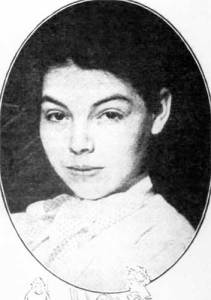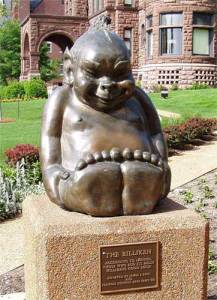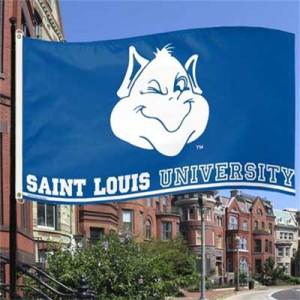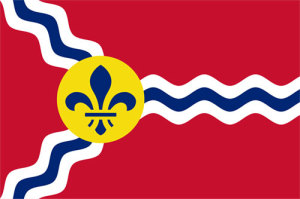What on earth is a Billiken flag? Ask St. Louis!

A young artist from the Midwest caused a sensation in 1909, little knowing she would inspire a flag that saluted sports at Saint Louis University, thanks to a coach’s portly shape. The cause was her creation of an inanimate object called a Billiken.
Florence Pretz was an aspiring artist and illustrator with an interest in Asia. Fiddling and doodling, she came up with a cartoonish image of a sort of Buddha figure and named it Billiken, a nonsense word. Declaring it a good-luck symbol, she captioned it “the god of things as they ought to be.”

Soon turned into a small statue, the Billiken quickly swept the nation. People clamored for one, starting a fad that rivaled later American manias, like the hula hoop and Cabbage Patch doll. But the sweet luck of Pretz quickly turned sour when she was bilked (billikened?) out of the rights to her creation. While others made money hand over fist as the statues flew off the shelves, she received a stipend of only $30 a month.
Meanwhile, at Saint Louis University, the Billiken was about to morph into a nickname and a mascot. According to the college, “There are several popular stories, all of which tie the Billiken to John Bender, who took over coaching SLU’s football team in 1910, and his resemblance to the cheery good luck symbol. According to one [legend], a cartoonist drew a caricature of the coach in the form of a Billiken and posted it in the window of a local drugstore. The football team soon became known as ‘Bender’s Billikens.’”

The university continued its account with “another version of the story [that] says that Billy Gunn, who ran a drug store near Saint Louis University, was responsible for the link. According to a 1946 obituary, ‘Coach Bender walked into Mr. Gunn’s drugstore one afternoon and was greeted by the proprietor with: Bender, you’re a real Billiken! William O’Connor, a noted sportswriter who was there, took up the name for Bender, and eventually the University teams became known as the Billikens.’”
Whatever the true story, the Saint Louis Billikens have played on sports fields and basketball courts for decades, and a university flag honors Pretz’s rotund god of good fortune.

As for the city of St. Louis itself, it has its own banner – without a human on it, although it once did feature one. The current flag, adopted 51 years ago, is fairly abstract. On a red field, three blue wavy lines form a “Y” lying on its side. The lines represent the Mississippi and Missouri rivers, and their confluence at St. Louis.
A gold circle located on the left side of the banner contains a fleur-de-lis in recognition of the French heritage of the city as well as the saint whose name the city uses. The previous St. Louis flag contained an image of the saint himself, seated atop a charger and holding a cross. The picture was eventually considered too Roman Catholic for a municipality of many diverse faiths or none at all.
Or those who worshiped the Billiken.
